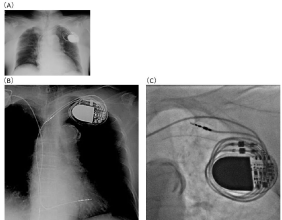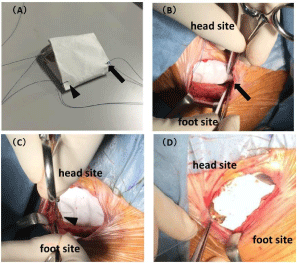
Case Report
Austin J Clin Cardiolog. 2016; 3(2): 1051.
How to Implant a Pacemaker for Reel Syndrome: A Method to Treat these Syndromes
Kinoshita H¹*, Sugino H¹, Tanaka K¹, Harada T¹, Yuasa K¹, Shimonaga T¹, Ichikawa O¹, Oka T¹ and Matsuda M1,2
¹Department of Cardiology, National Hospital Organization, Japan
²Department of General Medicine, National Hospital Organization, Japan
*Corresponding author: Haruyuki Kinoshita, Department of Cardiology, National Hospital Organization, Kure Medical Center Chugoku Cancer Center, 3-1 Aoyama-cho, Kure-shi, Hiroshima 737-0023, Japan
Received: October 14, 2016; Accepted: October 25, 2016; Published: October 26, 2016
Abstract
We report a case of an 83-year-old woman who deliberately tampered with the pacemaker’s placement site. We diagnosed this as Reel syndrome from clinical course. We wrapped a generator in a polytetrafluoroethylene sheet and affixed it to the large pectoral muscle at multiple points, other than the port, and prevented the generator from rotating in the longitudinal or horizontal direction intentionally from the body surface by the patient.
Keywords: Pacemaker dislodgement; Reel syndrome
Case Report
An 83-year-old female presented with the chief complaint of dizziness. She had a history of geriatric depression and delirium. A Dual-chamber (DDD) pacemaker had been implanted into her left breast and fixed to the greater pectoral muscle membrane for sick sinus syndrome when she was 81 years. In checking the pacemaker after eight months after the implantation, atrial sensing and pacing failure was discovered. Fortunately, the ventricular lead (V-lead) was functioning. Therefore, we continued to monitor it. Her dementia and depression turned worse to be progressive, and regardless of the repeated control of her daughter, she minded the pacemaker implanted place in her left chest and came to act tampering with it consciously from her body surface. One year after the first surgery, the V-lead dropped to the inferior vena cava, which could also be seen in the X-ray. The patient revealed that she had repeatedly rotated the generator from outside by herself. At first, we have been noticing only the dislodgement of the V-lead. However in half a year, we recognized the abnormal position of the atrial lead (A-lead) on the chest X-ray. We diagnosed this case as Reelsyndrome seeing theentangled lead image inside the pocket on the chest X-rays [1] (Figure 1). Reimplantation was considered because the patient experienced a symptom of light dizziness. We assumed that re-implantation inthe left breast might cause the patient to be nervous by fiddling with it in the dominant hand.

Figure 1: (A) The chest X-ray of pacemaker placement early days. (B) 13
months after pacemaker placement. (C) Entangled lead image of A-lead into
the pocket is further advanced and V-lead also fall out at 14 months after
pacemaker placement.
Therefore we implanted a new VVIpacemaker into the right breast. We wrapped the VVI pacemaker generator in a Gore-Tex sheetthat was 15 mm in diameter (W.L. Gore & Associates, Co., Ltd.,Tokyo) and affixed it to the pectorals major fascia using the stringsattached in three places, one through the generator port on its headside and two through the pericardial patch on its foot side (Figure 2).

Figure 2: To prevent the “turning-up” of the pacemaker, it would be necessary
to fix the generator with the pectoral fascia in multiple points in addition to the
port. (A) We wrapped the generator in a Gore-Tex sheet and fastened two
point with thread separately from the port (black triangle and arrow) and (B)
(C) these two points are fixed on the fascia with a thread to come to the foot
side of the patient, (D) port was fixed to come to the head side of the patient
at last.
Discussion
Reel syndrome is an occasional cause of pacemaker leaddislodgement, along with Twiddler’s syndrome [2]. Among patients who had Reel syndrome and Twiddler’s syndrome, there are many cases that led to dislodgement by the deliberate action of the patient. There are various countermeasures, such as re-tightening the loose attachments [3], affixing the pacemaker to the underlying fascia [4], and deep brain stimulation (for dystonia) [5]. However, there are not many reports that focus on countermeasures. Although there are many reports of the pacemaker being attached under the fascia, this method does not guarantee a solution every time [6]. Examples of patients who suffer from mental illness, dementia or children are thought to be a high risk group. As her dementia and depression progressed, she picked up the generator fixed to her left chest fascia from her body surface and repeated to give it three-dimensional rotational stress. Therefore we thought the generator needed to be fixed at more than three points. Fixing it at more than three points could thought to drop the generator due to the weight of the breast and thought to pull the leads. Therefore, we taped the breast at a position where the breast is drooping at the time of standing. In addition, this patientis right-handed. To prevent the patient from tampering the generator frequently, we have considered that implantation a pacemaker in the same side of the patient’s dominant hand is also one solution.
References
- Carnero-Varo A, Pérez-Paredes M, Ruiz-Ros JA, Gimenez-Cervantes. “Reel Syndrome”: a new form of Twiddler’s syndrome?. Circulation. 1999; 100: 45- 46.
- Bayliss CE, Beanlands DS, Baird RJ. The pacemaker-twiddler’s syndrome: a new complication of implantable transvenous pacemakers. Can Med Assoc J. 1968; 99: 371-373.
- Gamez Lopez AL, Bonilla Palomas JL, Granados AL. An unusual case of cardiac resynchronization therapy non-responder: the reel syndrome. Europace. 2010; 12: 778.
- Bali HK, Chattree KK, Bali SK, Chauhan HK, Shukla CP. A tale of early Reel syndrome caused by an over-enthusiastic masseuse. Indian Heart J. 2013; 65: 703-704.
- Menghetti C, Zekaj E, Saleh C, Porta M, Servello D. How to avoid Twiddler’s syndrome in deep brain stimulation for dystonia?. Neuromodulation. 2014; 17; 198-199.
- Bhatt DD, Gupta RK, Kaul U. Twiddler’s syndrome in a patient with CRT-D device - A case report. Indian Heart J. 2015; 67: 592-594.